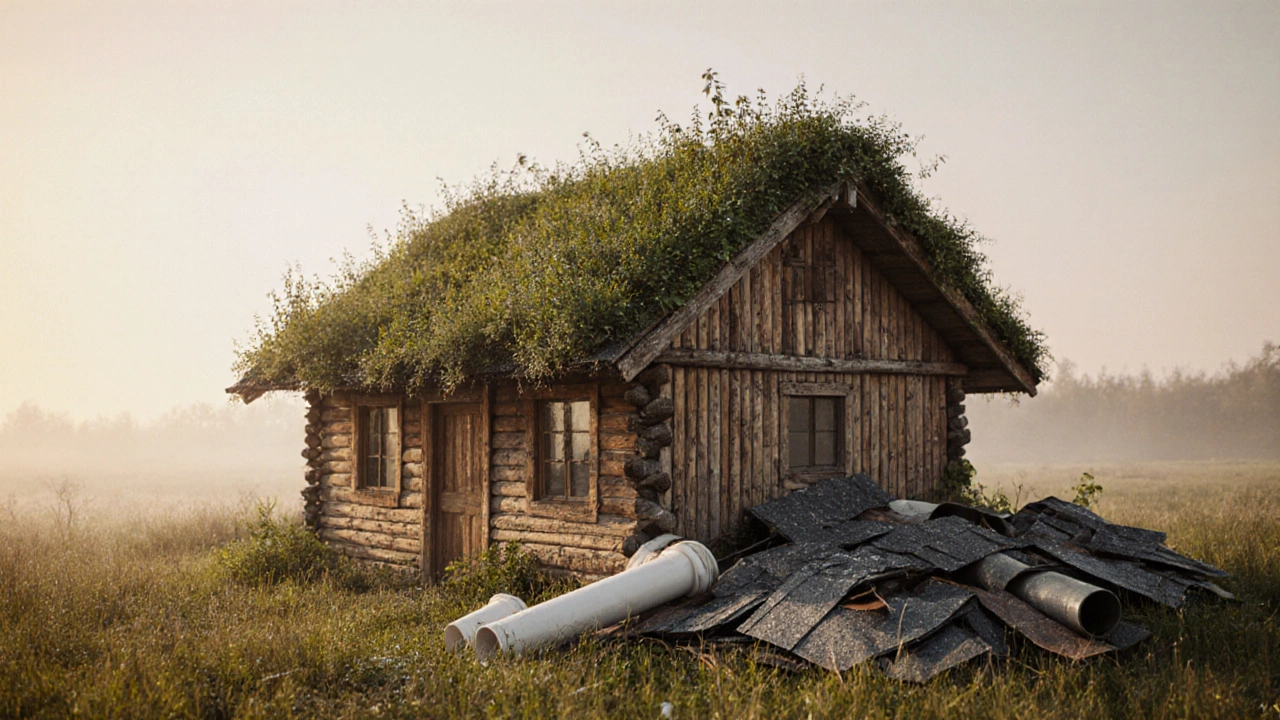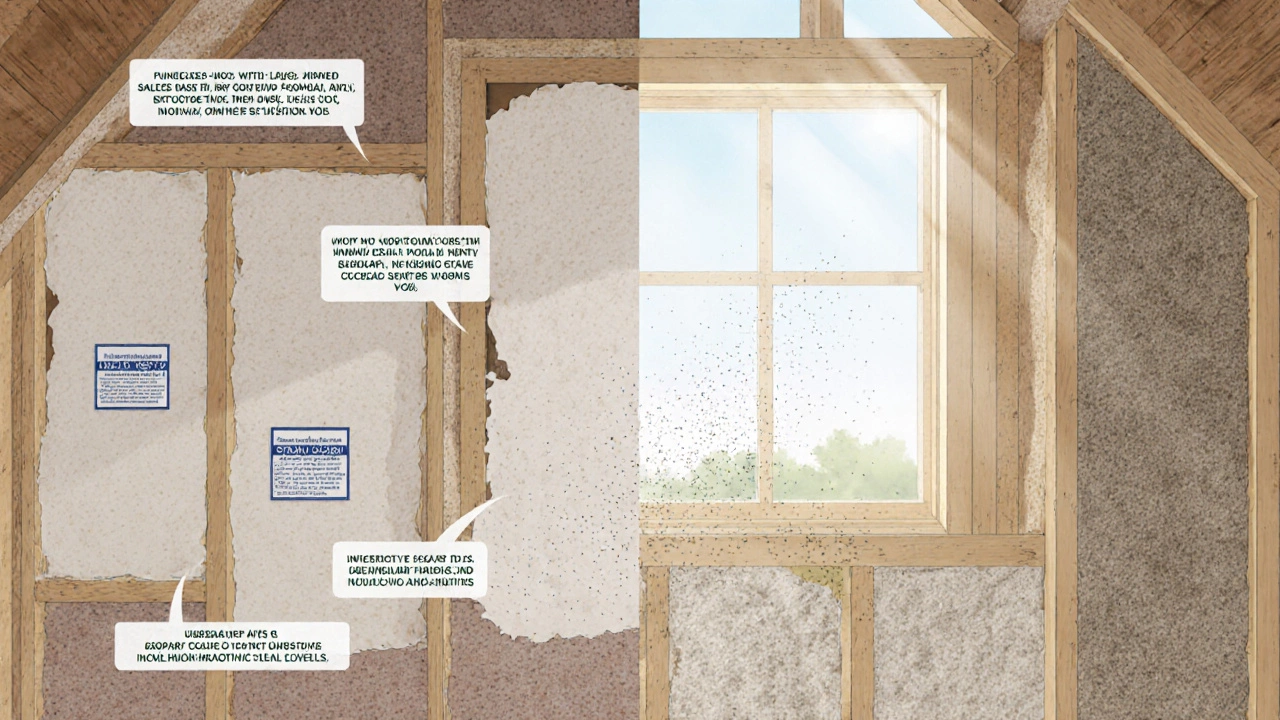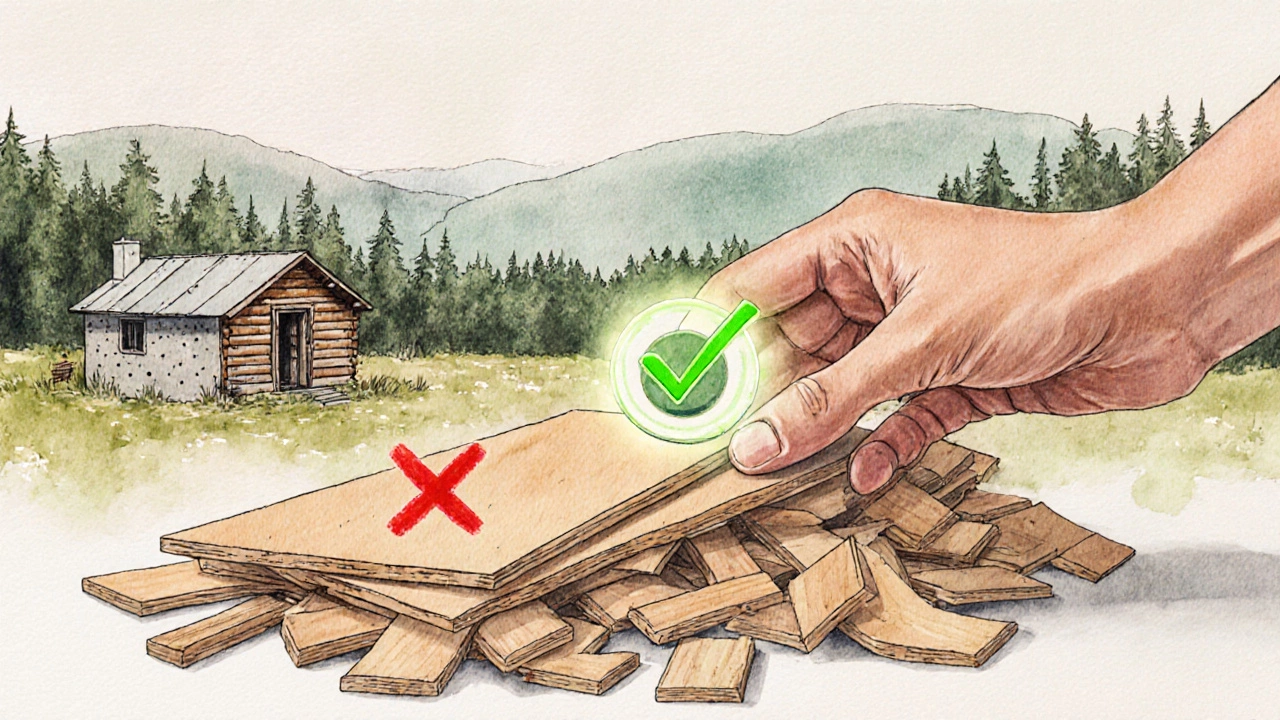What Building Materials Are Not Eco-Friendly? Top Harmful Choices for Eco-Friendly Cottages
 Nov, 8 2025
Nov, 8 2025
Eco-Friendly Building Material Checker
Check if your building materials are eco-friendly. Select materials you're considering for your eco-cottage and get instant safety ratings, environmental impact scores, and alternative recommendations.
When you’re building an eco-friendly cottage, you want clean air, low emissions, and materials that won’t poison the land or your family. But not all building materials are created equal. Some are still widely used - even in green projects - because they’re cheap, familiar, or easy to find. The problem? They’re far from eco-friendly. Here’s what to avoid if you care about the planet and your health.
Pressure-Treated Wood
Pressure-treated wood looks like ordinary lumber, but it’s soaked in chemicals to resist rot and insects. For decades, the go-to preservative was chromated copper arsenate (CCA), which contains arsenic - a known human carcinogen. Even though CCA was banned for residential use in the U.S. in 2003, you’ll still find it in older homes and some imported materials today. Modern alternatives like alkaline copper quaternary (ACQ) or copper azole (CA-B) are less toxic, but they still release copper and other metals into soil and water over time. These chemicals don’t just sit there - they leach out with rain, contaminate gardens, and harm beneficial insects and microbes in the soil. If you’re building a cottage near a garden, pond, or children’s play area, skip pressure-treated wood entirely. Use naturally rot-resistant woods like cedar, redwood, or bamboo instead.
PVC (Polyvinyl Chloride) Plumbing and Siding
PVC is everywhere: pipes, window frames, siding, flooring. It’s cheap, waterproof, and easy to install. But making PVC releases dioxins - among the most toxic chemicals known to science. Dioxins don’t break down. They stick around for decades, building up in the food chain and ending up in human fat tissue. Burning PVC - whether during construction waste disposal or in a house fire - releases hydrogen chloride gas and more dioxins. Even when it’s just sitting on your cottage wall, PVC can off-gas plasticizers like phthalates, which disrupt hormones. Many European countries have restricted PVC in residential construction. For plumbing, use PEX or copper. For siding, try fiber cement, reclaimed wood, or metal coated with non-toxic finishes.
Conventional Insulation: Fiberglass and Spray Foam
Fiberglass insulation is the default in most North American homes. It’s cheap and widely available. But installing it? You’re breathing in tiny glass fibers that can irritate your lungs and skin. And while fiberglass itself isn’t toxic, the binders used to hold it together often contain formaldehyde - a Group 1 carcinogen according to the World Health Organization. Spray foam insulation, especially petroleum-based polyurethane foam, is worse. It releases volatile organic compounds (VOCs) for months after installation. These VOCs can cause headaches, dizziness, and long-term respiratory damage. Plus, spray foam is made from fossil fuels and has a massive carbon footprint. Better options? Cellulose insulation made from recycled newspaper, wool insulation from sheep, or cork panels. They’re non-toxic, biodegradable, and even help regulate humidity.
Particleboard, MDF, and Other Engineered Wood Products
Particleboard, medium-density fiberboard (MDF), and plywood are used for cabinetry, shelving, and interior trim because they’re affordable and uniform. But they’re glued together with urea-formaldehyde resins. These adhesives slowly release formaldehyde into your cottage air - sometimes for years. The EPA says indoor formaldehyde levels can be 2 to 5 times higher than outdoor levels, mostly because of these materials. In tightly sealed eco-cottages, this becomes a serious health risk. Look for products labeled CARB2 compliant or, better yet, FSC-certified solid wood with natural finishes like linseed oil or beeswax. If you must use engineered wood, choose brands that use soy-based or no-added-formaldehyde (NAF) resins.

Traditional Concrete and Cement
Concrete is the most used material on Earth after water. But making cement - the key ingredient in concrete - is one of the biggest sources of CO₂ emissions globally. For every ton of cement produced, about 900 kg of carbon dioxide is released. That’s more than the entire aviation industry. Concrete also requires massive amounts of water and sand, leading to ecosystem destruction and water scarcity in many regions. While you can’t avoid concrete entirely in foundations or floors, you can reduce its impact. Use fly ash or slag as partial cement replacements - they’re industrial byproducts that lower emissions by up to 40%. Some companies now make carbon-negative concrete that absorbs CO₂ as it cures. For non-structural uses, consider rammed earth, hempcrete, or recycled aggregate concrete.
Synthetic Roofing: Asphalt Shingles
Asphalt shingles dominate the roofing market because they’re inexpensive and easy to install. But they’re made from petroleum, fiberglass, and mineral fillers. They’re not recyclable in most places and end up in landfills after 15-20 years. During installation and heat exposure, they release VOCs and heavy metals like zinc and copper. In heavy rain, runoff from asphalt roofs can carry these toxins into nearby soil and waterways. For a truly green roof, go with metal (recycled aluminum or steel), clay tiles, or living roofs covered in native plants. Metal roofs last 50+ years, reflect heat, and are 100% recyclable at end-of-life.
Paints and Sealants with High VOCs
Even in an eco-cottage, you might be tempted to use standard paint because it’s easy to find. But conventional paints contain volatile organic compounds (VOCs) that evaporate into your air. These chemicals contribute to smog and can cause everything from eye irritation to liver damage. The EPA says indoor air pollution is often 2 to 5 times higher than outdoor - and paint is a major contributor. Look for paints labeled zero-VOC or low-VOC, certified by Green Seal or Greenguard. Natural paints made from clay, lime, or plant oils are even better. They don’t off-gas, are breathable, and can actually improve indoor air quality. Same goes for sealants: avoid solvent-based products. Use water-based or natural oil finishes instead.

Why This Matters Beyond the Cottage
Choosing eco-friendly materials isn’t just about having a ‘green’ label. It’s about reducing your footprint at every stage: extraction, manufacturing, transport, use, and disposal. A material that’s cheap today might cost the planet - and your health - decades later. When you avoid these harmful materials, you’re not just building a cottage. You’re supporting cleaner factories, safer mining practices, and healthier ecosystems. And you’re setting a standard for others who want to build responsibly.
What to Use Instead
- Wood: Reclaimed timber, FSC-certified cedar or Douglas fir
- Insulation: Cellulose, wool, cork
- Insulation: Cellulose, wool, cork
- Plumbing: PEX, copper
- Roofing: Metal, clay tile, green roofs
- Paint: Zero-VOC or natural clay/lime paint
- Concrete alternative: Hempcrete, rammed earth, fly ash concrete
- Paneling: Solid wood with natural finishes, bamboo
It’s not about perfection. It’s about progress. Start by replacing the worst offenders - like spray foam and PVC - and work your way through the list. Every swap makes a difference.
Are all composite decking materials non-eco-friendly?
Not all. Traditional composite decking made from plastic and wood flour often uses virgin plastics and toxic binders. But newer brands use recycled plastic and natural fibers with non-toxic additives. Look for products certified by Cradle to Cradle or made with 90%+ recycled content. Avoid those with added biocides or UV stabilizers that leach into soil.
Can I use recycled materials and still have a safe cottage?
Yes - and you should. Recycled steel, reclaimed wood, and crushed concrete reduce demand for new resources. But test old materials for lead paint, asbestos, or chemical residues before reuse. Reclaimed timber from pre-1978 buildings may contain lead-based finishes. Always clean and seal with non-toxic products. Recycled materials aren’t automatically safe - they need proper vetting.
Is bamboo really eco-friendly?
Bamboo grows fast and absorbs more CO₂ than trees, making it a strong candidate. But not all bamboo products are equal. Some are glued with formaldehyde-based resins during processing. Look for bamboo certified by the Forest Stewardship Council (FSC) and labeled as low-VOC or no-added-formaldehyde. Also, check how far it was shipped - bamboo from China has a bigger carbon footprint than locally sourced wood.
What’s the most harmful material to avoid if I’m on a budget?
Spray foam insulation. It’s expensive upfront and toxic long-term. Even if you’re saving money elsewhere, skip it. Instead, use blown-in cellulose - it’s cheaper than spray foam, just as effective, and made from recycled paper. You’ll save on health costs, too.
Do eco-friendly materials cost more?
Sometimes upfront, but not always. Reclaimed wood, for example, can be cheaper than new lumber. Natural insulation like wool or cellulose costs about the same as fiberglass. The real savings come over time: lower energy bills, no health issues from toxins, and longer-lasting materials that don’t need replacing. Think long-term value, not just sticker price.
Next Steps for Your Eco-Cottage Build
Start by auditing your material list. Cross out anything with PVC, formaldehyde, or petroleum-based chemicals. Replace them with one alternative at a time. Talk to local suppliers who specialize in sustainable building - they often have hidden gems like reclaimed bricks or leftover insulation from green projects. Join online forums for off-grid builders or eco-home owners. Real people share real experiences: where they found affordable hempcrete, which paint didn’t peel after winter, or how they sealed a concrete floor without VOCs. Your cottage doesn’t need to be perfect. It just needs to be better than the last one.